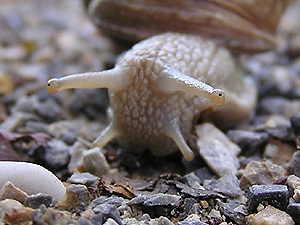
A Roman snail's head. [CK]
 A Roman snail's head. [CK] |
Observing a Roman snail crawling around, its eyes are easily seen: They are at the larger tentacles' tips. Without a magnification, the Roman snail's eye can be recognized as a black spot in the tentacles' terminal knobs. The snail examines its environment using its tentacles, withdrawing them quickly when it touches an obstacle. Especially the longer tentacles with the eyes are often withdrawn. This poses the question, how good a snail's eyesight really is.
Among gastropods, terrestrial pulmonate snails, such as the Roman snail, are among the most highly developed groups. This might best be explained by those snail groups having had to undergo most evolutionary changes to adapt to life on dry land. Comparing the eyes of all gastropods, all possible evolutionary stages can be seen. Like among all molluscs, in snails as well the development of the sense of sight is closely connected with their way of life. But, contrary for example to bivalves - mussels and clams - snails always have a head, even if they live in an almost immobile fashion.
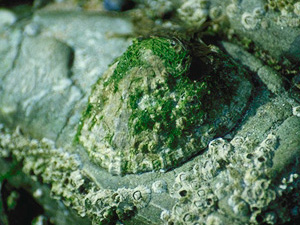 A limpet at its custromary resting place. Source: Morris, Currie: Rocky Shore Ecology. |
Especially in those gastropod groups with an almost immobile way of life, the simplest construction of eyes can be found. Among those snail groups mainly are the limpets (Patellidae). Limpets never leave the rock they are at home on, and their movement is limited to the path between settling place and feeding place.
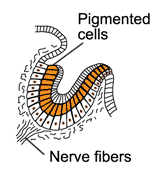 A limpet's cup shaped eye. |
For their needs, therefore, a simple cup shaped eye is quite enough. A cup shaped eye develops, when the outer skin (epthelium) caves in and light sense cells on opposites sides of the resulting cup can tell the difference between light and shadow. The effect is even increased by pigment cells isolating the sense cells against each other and mainly against lateral rays of light. Ocelles in the mantle rim of giant clams have the same construction.
How a cup-shaped eye is constructed clearly limits its visual abilities. Cup shaped eyes can only tell the difference between light and dark and also they can see where the light comes from. But they cannot distinguish forms and they can certainly not see any pictures.
Marine gastropods could only become more mobile, when their abilities of sight had improved. This happened, when the eye cup deepened and the visual opening narrowed. An effect was the result, which in historical time was used by the so-called pinhole camera: A picture of sufficient sharpness can be displayed by reducing the camera's aperture to the size of a pinhole. The smaller the aperture, the sharper the picture. But because there is only a small amount of light falling through the pinhole, the image will be quite dark. Besides, the displayed area of the image is very limited.
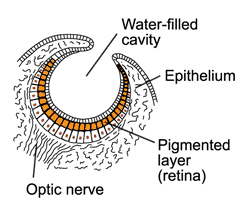 Pinhole eye of an ormer. |
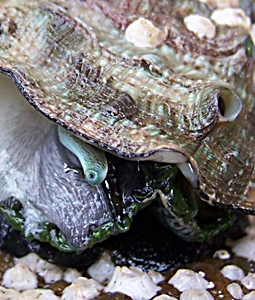 Green ormer (Haliotis tuberculata). Picture: Sylvie Danio, Nature 22: Gastéropodes 1. |
A pinhole camera eye today can be found in several marine gastropod groups, such as in ormers (Haliotidae) and in top shells (Trochidae).
Actually, a sea snail's pinhole eye is even slightly improved: The eye's internal cavity is filled by a refractive gelatinous secretion breaking the light rays. As a consequence, the visible image is brighter.
In spite of that, focusing the image is rather difficult. So it may be assumed that ormers and top shells more like see forms and shadows than a real picture.
This eye type may be sufficient for slow herbivorous snail species. But a precondition for the evolution of faster carnivorous species was a better visual organ, which enables the snail to see pictures and to recognize them.
In the course of this evolution, the outer skin epithelium grew over the eye's opening (the pupil) and a transparent layer of cells closed the eye to the outside. The refractive secretion in the inner eye developed into a round bubble or vesicle with better refractive properties. This type of eye is called a vesicular eye.
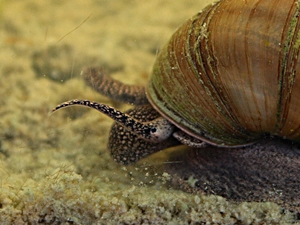 A mud snail (Viviparus contectus). At the tentacle base, there is a vesicular eye with a transparent cornea. Picture: © Alexander Mrkvicka, Vienna. |
Vesicular eyes are found in many gastropod groups in the sea and in fresh water, such as the apple snail Ampullaria.
Vesicular eyes have much better visual properties than more primitive eye types. Especially predatory gastropods (which is a large portion of the sea-living species) now could better recognize and follow their prey. But a very large part of hunting in gastropods still is following the prey's scent.
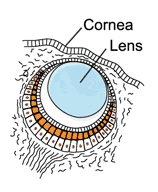 A Roman snail's simple lens eye. |
From the vesicular eye the lens eye developed when the vesicle of refractive secretion became more consistent, further improving the quality of the picture seen.
Real lens eyes, however, are mainly found in cephalopods. But cephalopod eyes, finally, have reached an evolutionary level to such an extent that they can easily compete with fish eyes. On the other hand, together with the evolution of pulmonate snails, resulting in the invasion of land, also the snails eyes improved considerably.
As a consequence the most refined organs of vision can be found among pulmonate snails, especially among terrestrial pulmonates, such as the Roman snail.
So to return to the example described in the beginning, the eye vesicle of a Roman snail clearly resembles a lens and usually terrestrial pulmonate eyes are referred to as lens eyes. However, the Roman snail is incapable of focusing its lens, because there is no ciliar muscle. Among molluscs, a ciliar muscle has only developed in the cephalopod group.
Examinations of Roman snails' eyes also discovered that Roman snail eyes only are equipped with two types of light sense cells. This is not sufficient to see colours. Besides, as there is no ciliar muscle, what a Roman snail sees, most probably is rather blurred. Simple experiments, however, could yield the result that snails easily can avoid larger obstacles and crawl around them. That they touch them with their tentacles, more likely ought to be a method of finding out more about the obstacle on short distance. Obviously that is something the snail's eye cannot do.
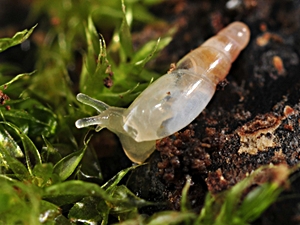 Common blind snail (Cecilioides acicula). Height ca. 5 mm. Picture: © A. Bertrand (Mollusques continentaux de France). |
Besides it is quite obvious that the eye in molluscs has evolved on another path than in vertebrates: In an everse eye, in which the sense cells point towards the eye's interior.
Apart from their eyes, snails have light sense cells distributed all over their body. Those are responsible for the so-called shadow reflex: If a shadow falls over a snail, it will quite swiftly withdraw into its shell, as a shadow in nature more than likely means a predator.
Snails also can be blind. On one hand, there are blind snail species especially among subterraneous groups, such as the ground snails (Férussaciidae), among them the common blind snail (Cecilioides acicula). On the other hand, Roman snails have been observed whose eyes had not been developed. Regardless of its blindness, this snail could easily find its way by using its tentacles. In Wales, even a blind slugs has recently been found. It is a predator living underground.
![]() The Evolution of the Mollusc Eye.
The Evolution of the Mollusc Eye.
![]() The light
sense in Roman snails.
The light
sense in Roman snails.
![]() Salvini-Plawen,
L.; Mizzaro-Wimmer,
M. (2001): Praktische Malakologie (Practical Malacology). Vienna.
Salvini-Plawen,
L.; Mizzaro-Wimmer,
M. (2001): Praktische Malakologie (Practical Malacology). Vienna.